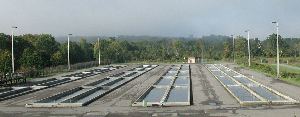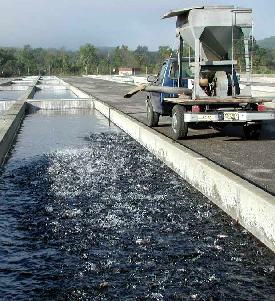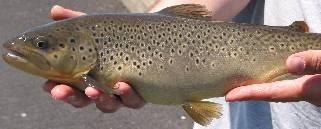| New Jersey Division of Fish and Wildlife |
Every year, on opening day of trout season, New Jersey's lakes and streams teem with trout, thanks to the work of staff at the Pequest Trout Hatchery. Last spring alone, the hatchery topped its stocking average of 600,000 trout by releasing an additional 30,000 fish.
 Pequest Hatchery raceways |
Located near Hackettstown in scenic Warren County, the Pequest Trout Hatchery began operations in fall 1982 with the arrival of 560,000 disease-free rainbow trout eggs shipped from the White Sulphur Springs National Fish Hatchery in West Virginia. That same year, Pequest obtained an additional 680,000 brook trout and 610,000 brown trout eggs from the North Attleboro National Fish Hatchery in Massachusetts. |
| Each year, the production
cycle begins in early fall when the staff collects and fertilizes trout
eggs in a process known as stripping. Stripping is done by manually applying
pressure to the trout's abdomen, forcing females to expel their eggs and
males to expel milt. Eggs and milt are mixed in plastic basins to achieve
fertilization.
To meet the hatchery's production goals, Pequest staff takes about 650,000 each of brook trout and rainbow trout eggs and about 400,000 brown trout eggs. The overall hatch rate of all three species averages approximately 65 percent. The fertilized eggs are placed in incubators where running water supplies oxygen until hatching, which generally takes 30 to 35 days. The hatchery's water supply comes from six artesian production wells in the Pequest Valley that provide up to 7,000 gallons per minute. Remaining at 52 degrees Fahrenheit year round, the continuous flow of water is critical to maintaining a trout production cycle. Upon hatching, the young trout are called "sac-fry" because the yolk sac remains attached to the trout's abdomen. The sac-fry are taken from the incubators and placed in fiberglass tanks in the main portion of Pequest's nursery building. The yolk sac nourishes the young fish for about two weeks. |
|
|
|
Once the yolk sac is absorbed, the fry are able to swim and will be fed a high-protein diet eight times a day by automatic feeders suspended over the nursery tanks. After the winter and early-spring growing cycles, the trout's survival rate is between 85 to 95 percent, and the fish, now called fingerlings, average three to four inches. |
| Fish are sorted by size,
and the fish densities in the tanks are reduced. Surplus fingerlings are
stocked or are used for interstate trading programs. Remaining fingerlings
are placed in outdoor pools, called raceways, at a rate of 13,500 fish per
pool. Throughout the summer, Pequest staff maintains 19 pools of brook trout,
19 pools of rainbow trout and 10 pools of brown trout.
After the summer growing period, the fish are again sorted for size. Numbers are reduced, and the raceways are reset at a rate of 12,500 fish per pool. This sorting generally yields about 48,000 surplus fish, averaging 5.8 inches. They are used for stocking during the third week of the fall trout stocking program. |
|
 Feeding raceway trout |
Meanwhile, fish that will be stocked in the spring are fed four times per day. Inventories are taken, and feed totals are calculated monthly to adjust growth rates of the trout. Pequest's goal is to produce fish that average 10.5 inches by spring, when up to 580,000 trout will be available for stocking. Pre-season spring stocking begins in mid-March; three weeks before opening day of the trout fishing season, trout are released throughout New Jersey. Excess and older broodstock are also liberated during this time. When stocking ends, there's no break in the action at Pequest. The cycle of raising fish from eggs is continuous, and before long, fish for next year's spring stocking will be in the outdoor raceways. |
| Other interesting programs are under way at the hatchery. For example, several pools unused in late summer and early fall are put into production to accommodate Pequest’s fall, winter, and sea-run trout stocking programs. The fall program yields about 45,000 yearling rainbow trout. Increasing water flows and feeding rates accelerated the growth of these yearling fish to an average of ten inches by the fall. |
 Brown trout |
|
|
Pequest’s winter program produces 12,000 rainbow trout that average about 11 inches, and are stocked in December and January every year. The sea-run program produces 30,000 surplus brown trout from the spring yearling sort. These brown trout are reared to eight inches and released in the estuary of the lower Manasquan River. The Pequest Trout Hatchery and Natural Resource Education Center offers self-guided tours of its trout production operations. The center is open daily from 10 a.m. to 4 p.m., excluding holidays. For information, call 908-637-4125. Learn more about Pequest. |